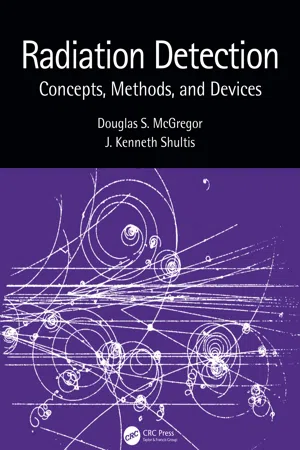Avogadro Constant
The Avogadro constant is the number of constituent particles, usually atoms or molecules, in one mole of a substance. It is approximately 6.022 x 10^23 mol^-1 and is a fundamental constant in chemistry. This constant allows chemists to relate the mass of a substance to the number of atoms or molecules it contains.
4 Key excerpts on "Avogadro Constant"
- eBook - ePub
Radiation Detection
Concepts, Methods, and Devices
- Douglas McGregor, J. Kenneth Shultis(Authors)
- 2020(Publication Date)
- CRC Press(Publisher)
...Appendix A Fundamental Physical Data and Conversion Factors A.1 Fundamental Physical Constants Although there are many physical constants, which determine the nature of our universe, the following values are of particular importance when dealing with atomic and nuclear phenomena. In 2017 the International Bureau of Weights and Measures defined the Avogadro Constant N a to be exactly the very large integer 6.02214076 × 10 23 entities per mol. This change redefined the mol as the amount of a substance containing N a entities (atoms, molecules, etc.). As a consequence, the molar mass constant M u is no longer 1 g/mol but now is 0.999 999 999 65(30) × 10 −3 kg mol −1. It also means that 1 mol of 12 C atoms no longer has a mass of 0.001 kg. However, the atomic mass unit remains unchanged as 1/12 the mass of a 12 C atom. On the 144th anniversary of the Metre Convention, 20 May 2019, the redefinition of SI base unit was affirmed and came into force. In the redefinition, four of the seven SI base units—the kilogram, ampere, kelvin, and mole—were redefined by setting exact numerical values for the Planck constant h, the elementary electric charge e (q e as used in this book), the Boltzmann constant k, and the Avogadro Constant N a, respectively. A.2 The Periodic Table The periodic table presented in Table A.2 uses the new group format numbers from 1 to 18 approved by the International Union of Pure and Applied Chemistry (IUPAC), while the numbering system used by the Chemical Abstract Service is given in parentheses at the top of each column. In the left of each elemental square, the number of electrons in each of the various electron shells are given. In the upper right of each square, the melting point (MP), boiling point (BP), and critical point (CP) temperatures are given in degrees Celsius. Sublimation and critical temperatures are indicated by s and t...
- eBook - ePub
- Colin Salter(Author)
- 2021(Publication Date)
- Pavilion(Publisher)
...In combination with the work of later scientists, including Michael Faraday, it led to the Avogadro Constant, named in his honour, which is the total number of particles that make up a measure known as a mole. Moles may differ in mass and volume, but they all contain the same number of particles, be they ions, electrons, atoms or molecules. The number, the Avogadro Constant, is 6.02214076×1023. Avogadro achieved a rare feat by getting his law of gasses printed on an Italian postage stamp in 1956. Amedeo Avogadro was born in Turin and spent his life there, teaching and researching at the University of Turin....
- eBook - ePub
- Alan J. Cann(Author)
- 2013(Publication Date)
- Wiley(Publisher)
...4 Molarities and Dilutions LEARNING OBJECTIVES: On completing this chapter, you should be able to: understand the concepts of molarity and concentrations; be able to calculate the molarity of solutions; be able to calculate dilutions of solutions and suspensions. 4.1. Avogadro’s number In the last chapter, we learned that the mole (from ‘molecule’) is the SI unit used to measure the amount of a substance (abbreviation = ‘mol’). Technically, one mole is ‘the amount of a substance which contains as many elementary entities as there are atoms in 0.012 kg of carbon-12’. This is a complicated definition, but in 1811 Amedeo Avogadro was the first person to clearly make the distinction between molecules and atoms. Avogadro suggested that equal volumes of all gases at the same temperature and pressure contain the same number of molecules, which is now known as Avogadro’s Principle. However, it was not until long after Avogadro’s death that the idea of the mole was introduced. The molecular weight in grams (1 mol) of any substance contains the same number of molecules. The number of molecules in 1 mol is now called Avogadro’s number. Avogadro had no knowledge of moles, or of the number that was to bear his name, since this was never determined by Avogadro himself. Avogadro’s number is: How big is Avogadro’s number? 1. An Avogadro’s number of soft drink cans would cover the entire surface of the earth to a depth of over 200 miles. 2. If we were able to count atoms at the rate of 10 million per second, it would take about 2 billion years to count the atoms in 1 mol. 3. An Avogadro’s number of carbon-12 atoms (1 mol) weighs 12 g. An Avogadro’s number of moles of carbon-12 weighs the same as the Earth. 4.2. Molecular weight To have to consider the masses of individual molecules measured in grams would be very inconvenient, since this would involve extremely small numbers...
- eBook - ePub
Digital Integrated Circuits
Analysis and Design, Second Edition
- John E. Ayers(Author)
- 2018(Publication Date)
- CRC Press(Publisher)
...Appendix E Physical Constants Quantity Symbol Value Avogadro Constant N A 6.022 × 10 23 mol −1 Bohr radius a B 5.292 × 10 −11 m Boltzmann constant * k 1.381 × 10 −23 J / K Electron rest mass m 0 9.110 × 10 −31 kg Electron charge q 1.602 × 10 −19 C Gas constant R 1.987 cal / molK Permeability of free space μ 0 4 π × 10 −9 H / cm Permittivity of free space ε 0 8.85 × 10 −14 F / cm Planck constant h 6.626 × 10 −34 Js Reduced Planck constant η 1.0546 ×. 10 −34 Js Speed of light in free space c 3.00 × 10 10 cm / s * In work with semiconductors, the value k = 8.62 × 10 −5 eV / K is often used....



